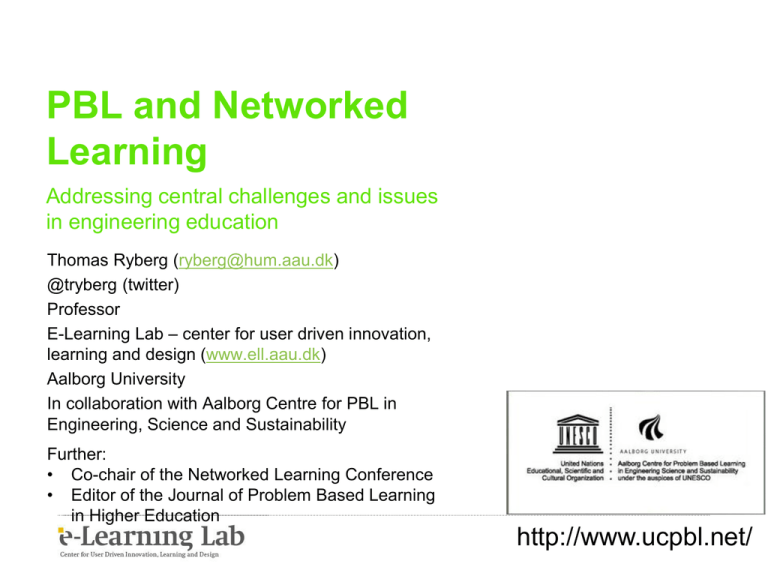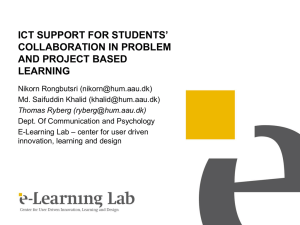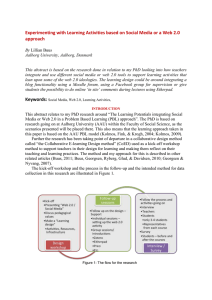2015 9 Ryberg CONFEA presentation Trimmed
advertisement

PBL and Networked Learning Addressing central challenges and issues in engineering education Thomas Ryberg (ryberg@hum.aau.dk) @tryberg (twitter) Professor E-Learning Lab – center for user driven innovation, learning and design (www.ell.aau.dk) Aalborg University In collaboration with Aalborg Centre for PBL in Engineering, Science and Sustainability Further: • Co-chair of the Networked Learning Conference • Editor of the Journal of Problem Based Learning in Higher Education http://www.ucpbl.net/ A new kind of University? Bøgelund. P. (2015). How supervisors perceive PhD supervision – And how they practice it. International Journal of Doctoral Studies, 10, 39-55. Retrieved from http://ijds.org/Volume10/IJDSv10p039-055Bogelund0714.pdf Mode 1 Academia and the disciplines Kolmos, 2015 Orientation to academia and theory Orientation to Companies and instrumental practice Mode 2 Market-driven ICT Explicit PBL skills Leadership Cultural diversity and integration International research and theory External stakeholders Orientation to community Mode 3 Community driven - An Integrative Approach The Aalborg PBL model • Problem Based Learning – Based on real-life problems • Project Organised Education - Project work supported by lectures and courses • Group Work - groups of four to six students - supervised by lecturers/professors • Interdisciplinary Studies - Integration of theory and practice - Focus on Learning to Learn and methodological skills • University Wide Model - Used in all faculties (with variations) Problem Based Learning – the Process – 3-4 months Literature Problem Analysis Tutorials Lectures Problem Solving Field work Group Studies Project Report Experiment s Students’ use of time - lectures, courses and project work 50 % 50 % Project work : a major assignment within a given subject-related framework determined for each semester (thematic framework). (15 ECTS) Course work – 3 x 5 ECTS modules with an exam NETWORKED LEARNING – FROM BROADCAST TO COLLABORATION Complex maasive social and personal networks THIS! Changes in the educational technological landscape • From hierarchical structures based on courses and topics towards more student centred networks • From distribution to more horizontal patterns of exchange – peer-learning • From Learning Management Systems (LMS) Personal Learning Environments (PLEs) Personal Learning Networks (PLNs) Ego-centric networks formed through e.g. social network sites (facebook, twitter, pinterest) Traversing and harvesting the ego-centric network for information, ideas, and resources (and contributing) The individual person’s ability to form and sustain a personal learning network Many strengths and potentials – but heavily individualised notions of learning underpinning the ideas of PLNs Mass collaboration Diffuse, uncoordinated mass of people contribute to sustained or more ephemeral constructs Sustained: Wikipedia, Open Source. #nlc2016, Some MOOCs Ephemeral: wild-fire or flash activites – #jegharoplevet – eruptions and burst of hectic activies – short-lived activation of massive networks Many strengths and potentials – but what is the quality of the contributions, how to get an overview, diffuse and chaotic, no joint goal – requires knowledge and literacy to draw from and make sense of (information overload) Too much online/distance learning is: • We have new spaces for networking and collaboration and co-construction of knowledge – however much online learning is: – – – – Replicating traditional courses Talking heads (video lectures) + quizzes Largely teacher-centred Disciplinary and not practice oriented e.g. active learning and problem solving • We need to move from pedagogies of broadcasting to pedagogies of collaboration and production New formats – just one idea • How about rethinking courses - moving from online courses to Cooperative Open Online Projects – Solve real-world large-scale problems together – Collaborations (e.g. 12 weeks) between researchers, students and industry to work on particular ”grand challenges” – access to water, climate change, waste management – Cross-cultural and trans-disciplinary teams from e.g. Europe, South America, Africa – Combinations of theory, inquiry, problem solving – theory and methods emerge from the challenges – Online collaborations and remote access to field site via video, case presentations by local students


